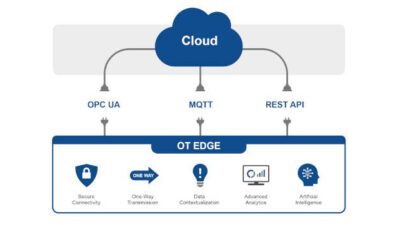IIoT gateway connections: Industrial Internet of Things (IIoT) and Industrie 4.0 connect industrial automation devices and equipment, or “things,” with cloud-based systems to harvest information faster and to drive business value by providing new services to customers.
The ever-expanding Industrial Internet of Things (IIoT), sometimes referred to as IoT for applications beyond industrial automation, brings a vast communications infrastructure to the process, factory, and building automation industries; one that is far beyond anything these industries have typically used. With cloud communications services available from several companies spread across the planet-including Microsoft, Amazon, and others—it has never been easier or more cost-effective to connect even the smallest and least expensive devices to a network—and not just to a local network, but to one that spans the globe.
IoT carries vast amounts of processing power to the process, factory, and building automation industries. This processing power, which can also be found in the cloud, is scalable from one CPU with limited memory and disk space to a large array of CPUs or servers. If used effectively, this processing power can be applied to monitor and analyze data, to report events and results, and to solve problems that could never have been solved before.
Scalable software
Many organizations embarking on their IoT initiative seek "off-the-shelf," scalable software applications to enable monitoring, visualization of data, real-time analytics, and much more. Because of the openness and standardization in emerging communications protocols, many of these applications are serviceable with minimal configuration and with little or no middleware.
Achieving these benefits requires the availability of low-cost bridging devices called "IoT gateways." IoT gateways communicate to the exiting sensors and automation controllers called "edge devices" and provide the bridge between an on-premise communications network and cloud-based computing power and visualization. IoT gateways must have the ability to interface with industry standard protocols such as OPC UA (Unified Architecture), BACnet, Modbus, Simple Network Management Protocol (SNMP), or web services, but can sometimes use proprietary communications protocols as well.
IoT gateway
Connectivity is key. Without being able to connect edge devices from behind firewalls and securely publish data to cloud-based applications, organizations will not be able to achieve the promises of advanced analytics through computing power in the cloud. A premium IoT gateway, for instance, should be able to communicate with Microsoft Azure or third-party applications using the most popular transport protocols. Once the IoT gateway is online, it can register with the IoT Hub in the Azure cloud through a secure Advanced Message Queuing Protocol (AMQP) so that it can authenticate, send, and receive data. Acting as a secure message broker, the IoT Hub can allow for remote device management, provisioning, and configuration. The IoT gateway should be able to work with enterprise resource planning (ERP), manufacturing execution systems (MES), and other enterprise applications running in private or public clouds other than Azure using Representational State Transfer (REST) and Message Queuing Telemetry Transport (MQTT) as established IoT transport protocols.
IIoT and Industry 4.0 represent the advent of connecting industrial automation devices and equipment, or "things," with cloud-based systems to harvest hidden information faster than ever and to drive business value by providing new services to customers. The benefits to organizations, line of business applications, and customers may be attained in the form of cost reduction, new revenue streams, or an improved customer experience.
Oliver Gruner is the director of cloud business development at Iconics. Gruner graduated from the University of Applied Science Friedberg, Germany, with a B.S. in Industrial Engineering. Edited by Mark T. Hoske, content manager, CFE Media, Control Engineering, [email protected].
More advice
Key concepts
- Industrial Internet of Things (IIoT) improves connectedness for processes, factories, and building automation.
- IoT gateways connect to cloud-based computing and analysis.
- Information should connect to existing systems for the best value.
Consider this
Does your human-machine interface (HMI) software promote easier mobile connectivity?
ONLINE extra
See related product information linked to this article online, including a whitepaper titled "Iconics IoT Gateway Suite" here:
See related stories from Iconics linked below.



